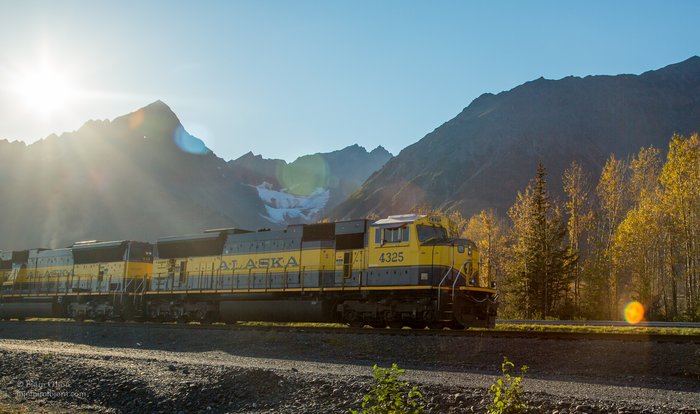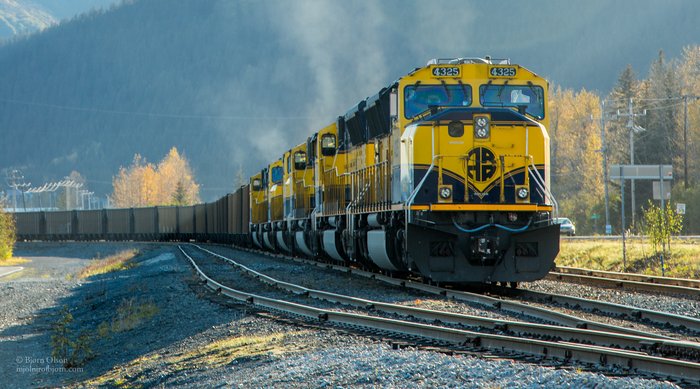
The Alaska railroad is a railway system which runs up through central Alaska, linking the major population and industrial centers of southcentral and interior Alaska. The mainline track stretches 470 miles, from Seward and Whittier to Fairbanks (technically a little further, to Fort Wainwright and Eielson Air Force Base). At one of its southern ends, the railroad terminates at the Seward Coal Loading Facility, where coal is loaded onto ships for export. The Alaska Railroad is crucial to some of the state’s industries - notably coal mining and the now-closed refinery in North Pole.
“The Alaska Railroad” also refers to the Alaska Railroad Corporation, the state-owned corporation which operates the rail system, and which owns the track, land, trains, and other infrastructure and equipment. The railroad is heavily subsidized by both the state and federal governments, which have historically financed most of its infrastructure, currently valued at close to $1 billion.

ALASKA RAILROAD FREIGHT TRAIN
 — 
<a class="figure-caption__link" href="/photos/alaska-railroad-freight-train/">Get Photo</a></figcaption></figure> Service & Finances
The Alaska Railroad funds its operations and maintenance through customer fees and other business activities, whereas its infrastructure is funded by grants. The railroad offers passenger and freight service, with freight fees being its largest single source of income. In 2013,4.8 MB freight provided 51% of its revenues, followed by grants (21%), passenger service (14%), real estate (10%), and other activities (4%).
In terms of actual dollar amounts, in 2013, the railroad took in $97 million in freight fees, $26 million in passenger fees, and $40 million grants. Until recently, the largest single client of the Alaska Railroad was the Flint Hills refinery in North Pole. At present, Usibelli Coal Mine is likely the largest current client in tonnage (but possibly not in fees).
The Alaska Railroad self-reports as being in a very difficult current financial position (see 2013 Annual Report4.8 MB). Revenues have declined to a point where soon it may be unable to maintain its current infrastructure and operations, if it does not increase business or grant inflow. The railroad’s decline in revenue is mainly due to less grant income, and less freight fees. Government grants have been squeezed by state and federal budgetary limitations.
The decline in freight fees, on the other hand, has been driven primarily by the closure of the North Pole refinery. Tonnage decline has also been driven by the weak export market for coal, which accounted for something less than 30% of 2013 freight moved. Usbelli mined3.9 MB 1.6 million tons in 2013 but burned some of that at its mine-mouth plant; the railroad moved a total of 5.5 million tons of freight that same year. Coal is shipped at a low price. Analysis of Alaska Railroad annual reports suggests that coal fees probably accounted for less than 10% of freight revenues in 2013.
The Alaska Railroad has historically been heavily subsidized by the state and federal governments. This is characteristic of the whole U.S. rail system, which was built with strong government support (including very extensive land grants) and continues to be government supported. As of 2013, the Alaska Railroad had around $900 million of capital assets (track, land, trains, and so forth), of which about $600 million is identified in its recent Annual Reports as funded by state or federal grants. Like most railroads, the Alaska Railroad is a major landowner as well as being a transportation operator, and real estate is an important part of its asset portfolio and ancillary business activity.
## Projects and Expansions
ALASKA RAILROAD FREIGHT TRAIN (2)
 — 
<a class="figure-caption__link" href="/photos/alaska-railroad-freight-train-2/">Get Photo</a></figcaption></figure>As of 2015, the railroad is building two grant-funded railway expansions: the Port MacKenzie Railway Extension and bulk export facility on Cook Inlet, and the Northern Railway Extension, which will cross the Tanana River near Fairbanks.
Simultaneously, the railroad has an unfunded federal mandate (like all U.S. Railroads) to install a Positive Train Control system before the end of 2015. This system, designed to prevent human error-caused derailments and accidents, will cost an estimated $150 million - about equal to the entire annual operating budget of the railroad. The PTC mandate is a major financial stress on the railroad.
Economic Importance of the Alaska Railroad
The Alaska Railroad provides heavy-duty transportation infrastructure for construction, resource extraction, and other industries requireing heavy lift capacity along its route. It also inexpensively moves large tonnages of general goods into the interior. The Railroad does not release details about who its freight activities, although some hints can be gleaned from media articles and Annual Reports.
Most notably, rail transportation is critical for Usibelli Coal to move coal from its Healy-area mine to Fairbanks-area powerplants and to Seward for export. Until recently, the railroad transported petroleum distillates from the Flint Hills refinery in North Pole. The railroad may play some role in supporting Alaska’s major interior mines, Fort Knox and Pogo, such as by moving heavy equipment. Other industrial cargos may include aggregate (gravel) and forestry products (such as wood pellets.) The railroad was instrumental in building the Trans-Alaska Pipeline, and would likewise be a major carrier for the construction of any new large industrial facilities in the interior - such as a North Slope gas pipeline.
Overall, the Alaska Railroad makes moving heavy cargo through the Railbelt less expensive. As a general rule, rail is one of the most energy-efficient and carbon-efficient forms of modern heavy transport, along with shipping and pipelines. Absent the Alaska Railroad, many goods would have to be moved through interior Alaska by trucks, or by the circuitous and seasonal Bering Sea / Yukon River water route. The price of transported goods, particularly heavy goods, might climb dramatically if the railroad closed, and businesses which rely on its cheap freight-moving capacity would likely close.
By lowering the price-to-customers of moving large quantities of heavy goods through the Railbelt, the Alaska Railroad likely encourages commerice and industrial development in the interior, lowers the prices of many products, and makes its clients’ businesses more profitable.
The extensive railroad subsidies benefits all users who have reduced fees for transport as a result, but it probably most strongly benefits those enterprizes which use the railroad most heavily and which can negotiate the lowest fees per ton-mile. For more description of this dynamic, see our article on the long-term impacts of coal development.
Further Reading
Created: Jan. 19, 2018